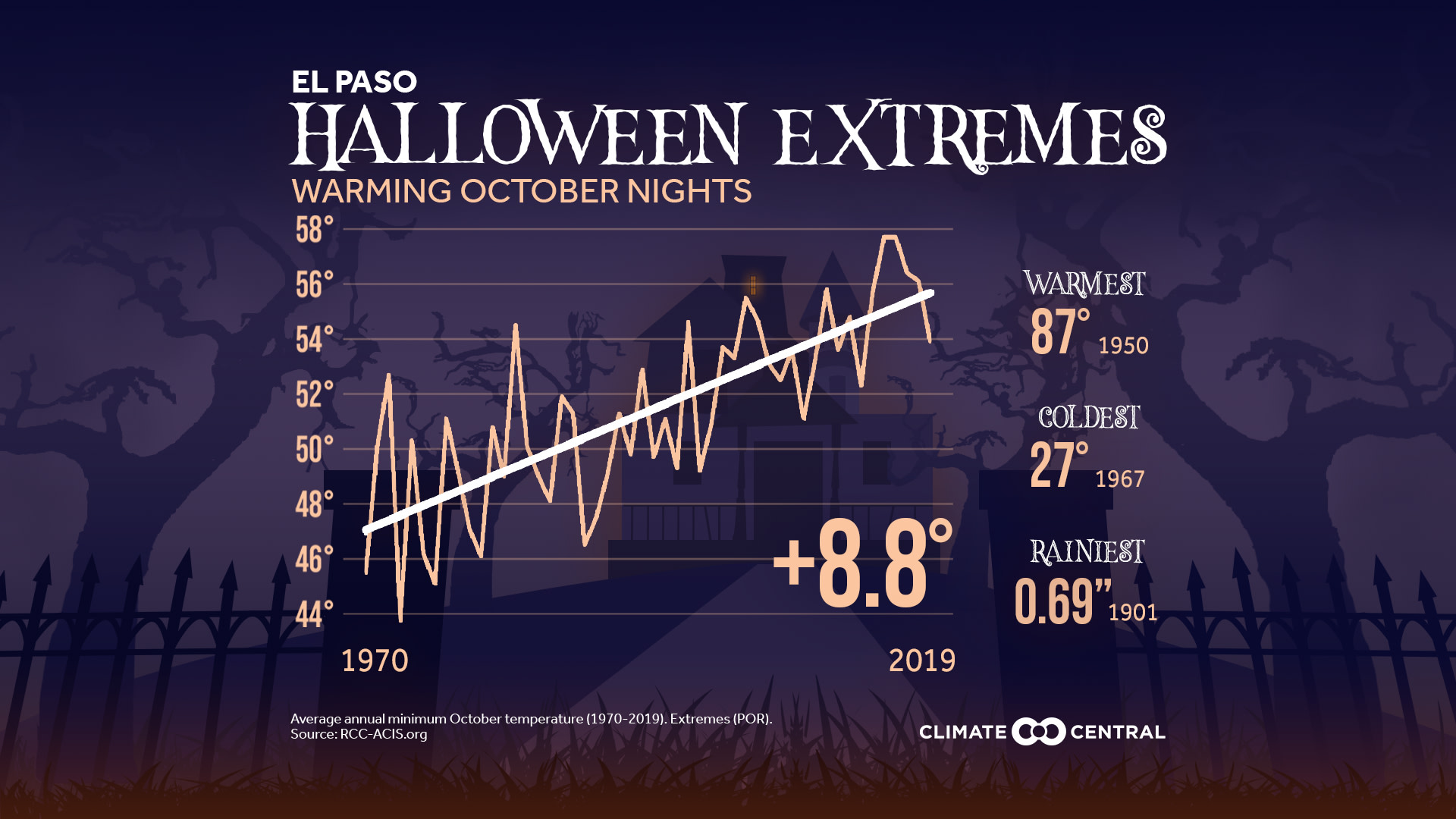KEY CONCEPTS
With Halloween a couple days away, Climate Central examines Halloween extremes—the coldest, warmest, rainiest, and snowiest October 31sts’ on record for 242 cities—as well as the warming trend of October nights.
From 1970 to 2019, 88% (212) of the 242 cities analyzed had an increase in their October minimum temperatures, consistent with the overall fall warming trend caused by climate change.
Traditional October and fall festivities, like trick-or-treating and pumpkin picking, may undergo some changes as our climate warms. Increased global temperatures can help amplify wet and dry conditions regionally, and as a result, threaten cocoa bean and pumpkin harvests.
With an ongoing pandemic, 2020 has already been a frightful year for most. But as Halloween approaches, more than 148 million still plan to indulge in their spooky traditions amidst Covid-19. Nevertheless as many dress up as witches, vampires, and ghosts, we must remain vigilant of another monster lurking in the shadows—climate change.
In the spirit of Halloween, Climate Central examined Halloween extremes by reporting the coldest, warmest, rainiest, and snowiest October 31sts’ on record for 242 cities. In addition, we analyzed minimum temperature trends in the month of October from 1970 to 2019, which unearthed some spooky statistics. Of the 242 cities analyzed, 88% (212) experienced an increase in their average nightly October temperatures. The greatest increases reported were in Reno, Nev. (+11.6°F), El Paso, TX (+8.8°F), Las Vegas (+8.7°F), and Panama City, Fla. (+8.7°F).
The warming trend of October nights reflects the overall warming trend of the fall season. These trends, largely caused by human-induced climate change, have many implications, including an extended allergy season and a longer disease-carrying mosquito and tick season.
Climate change can also put a damper on Halloween and other festive fall activities. Pumpkins, traditionally picked and carved for Halloween, are at a potential risk. As global temperatures increase, some regions in the U.S. (e.g., Northeast and Midwest) will experience wetter conditions, on average, that produce lower quality pumpkins and make them more susceptible to diseases. A foreshadowing of this happened in Morton, Ill., where above-average precipitation in 2015 rotted their harvest, resulting in a nationwide pumpkin shortage.
And, unfortunately, the news does not get any sweeter for Halloween. Chocolate, a fan-favorite in trick-or-treat bags, is also threatened by climate change. Research indicates that El Niño-related droughts, which could become longer and more frequent under climate change, could significantly decrease cocoa bean production in Brazil. Also, areas of West Africa—that has about 70% of the world’s cacao trees—could lose up to 40% of their suitability for cacao trees by 2050. Some chocolate companies have already taken action, like pledging to source their chocolate sustainably. However, the strongest solution proposed is cutting company emissions because reducing greenhouse gases is our best bet at defeating the monster that is climate change.
POTENTIAL LOCAL STORY ANGLES
How are fall harvests in your state affected by climate change?
Due to climate change-strengthened droughts, precipitation, and extreme weather, agricultural productivity is expected to decrease in some regions. Check out crop conditions and progression on the U.S. Department of Agriculture website, which reports weekly fall harvest progress for each state.
How are farmers in your area preparing for the negative impacts of climate change?
The USDA released a comprehensive report on climate change and agriculture in the U.S., highlighting the effects and adaptations. For more region-specific management plans and reports by farmers and farming communities, check out the USDA Climate Hubs webpage.
What other specialty foods are threatened by climate change?
In addition to cocoa beans, there are several other specialty crops under threat of climate change across the world. Check out a list of 12 foods outlined here.
LOCAL EXPERTS
To get in touch with your local farmers on the impact of climate change and harvests, check out the directories provided by the USDA. The SciLine service, 500 Women Scientists or the press offices of local universities may be able to connect you with local scientists who have expertise on climate change and crop production in your area. In addition, the American Association of State Climatologists is a professional scientific organization composed of all state climatologists.
NATIONAL EXPERTS
Jim Angel, Ph.D.
Former Illinois State Climatologist (1997-2018)
Prairie Research Institute, University of Illinois
Lead Author, Midwest Chapter of the 4th National Climate Assessment
Discussion topics: fall harvest and climate change
jimangel@illinois.eduDoreen Stabinsky, Ph.D.
Professor of Global Environmental Politics, College of the Atlantic
Discussion Topics: climate change impacts on agriculture and food security
dstabinsky@coa.edu
METHODOLOGY
Climate extremes for October 31st and average minimum temperatures for the month of October were calculated using temperature and precipitation data from the Applied Climate Information System. Average minimum temperatures were analyzed from 1970 to 2019 while climate extremes were investigated over each station's entire period of record. Climate Central's local analyses include 244 stations. However, for data summaries based on linear trends, only 242 stations are included due to large data gaps in St. Johnsbury, Vt. and Wheeling, W. Va.
